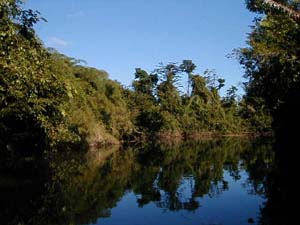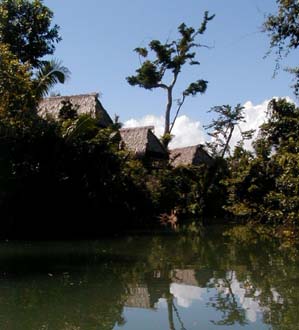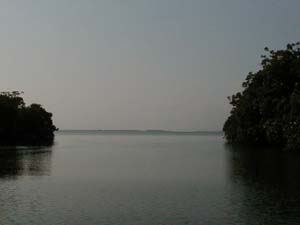 |
On the hillside in the near distance we could see the roof of the visitor's center for the ancient Maya city of Nim Li Punit holding a constant and watchful vigil over the Boden Creek Preserve as it reaches towards the Seven Hills of Toledo. It had been a short drive up to the side gate of the private reserve from the comfort and genuine hospitality afforded to us at the time by the skeleton staff of the opened though not officially, Indian Creek Lodge. The Indian Creek Lodge is one of three lodges in the property chain operating under the umbrella of Belize Lodge & Excursions Ltd.. The place truly represents excellent eco planning, especially in light of what they have achieved by starting with what was left over of an old banana plantation. Then the devastation and havoc reaped upon the flora and fauna by Hurricane Iris didn't help matters. |
The guard posted on his front porch diagonally across the road from the entrance was stirred by the curious activity along the lonesome stretch, but quickly his concern gave way to a broad smile as he waived to my guide Thomas as he latched the entrance gate behind us. As we soaked in the last benefits of the trucks air conditioner, we entered the private lands of the reserve known locally these days as the land holdings of Belize Lodge & Excursions. In the old days, the land was a sprawling and prospering banana plantation at a time when a future in the industry appeared promising. Today the land has been purchased and refinanced by a consortium of environmentalist. From our canoe 'put in' at the companies Fig Tree Landing on the Golden Stream about a mile in from the Southern Highway, we said our goodbyes to what you can call civilization in Southern Belize and began our twisting paddling adventure. My guide B.J. and I were lost in time as we floated aimlessly down the Golden Stream in our two person canoe engulfed in the sheer natural beauty. It was late in the wet season, but the water remained high from the road to the coast. Overhanging fallen trees and broken branches littered the way forcing us to portage the canoe and equipment on several occasions. |
||||||||||||||
About
three hours into our leisurely paddling through gentle waters,
we popped out from under the jungle canopy lowland tropical broadleaf
forest arriving to BLE's Jungle Lodge. Accessible either by canoe
or by a network of hiking trails from the Indian Creek base lodge,
this lodge supports the guests who are lodged in a handful of
well-appointed thatch roofed cabanas that seem to hang in mid
air over the Golden Stream. As of this writing BLE requires a
one night minimum at the Indian Creek Lodge and a two night minimum
stay at the Jungle Lodge.
Following a restful night, I was sent off with a hardy English style breakfast. Maya guide B.J. and I departed the jungle lodge around 8am, timing our paddle towards the coast to coincide with the awakening of the abundant bird life. The Toledo District boasts over 500 species of birds. Along the river's edge giant Iguanas found warmth in the sunlight on branches of fallen trees. The Golden Stream eventually began to widen as we approached the last few turns towards the sea. We arrived late morning to the mouth of the Golden Stream, paddling into the overflow as it merges into the Port Honduras Marine Reserve. There we were met by BLE's speedboat for the 25 minute ride back to Punta Gorda. |
||||||||
 |
A RIVER SAFETY TIPwith Tim Truman There
are many different types of rivers, from raging torrents to placid
waters where the flow is difficult to distinguish. All deserve
your attention so that you are not the aim of ridicule around
the fire at the end of the day! So, with that in mind, here are
some basic tips to keep things flowing.
First off, make sure your equipment is in good order. Your equipment should include: a boat with no leaks, paddles, PFD's, a first aid kit, and a rope for tying the boat off when you want to check out a cool waterfall. Secondly, always have an action plan to go by in case something unexpected happens. Let someone know that you are on the water and check to see if there are any areas downstream that will be close to roads in case of an emergency. A vehicle at the takeout makes for a much easier time getting back and also is valuable in case of emergency. If there is a group boating together, it is extremely helpful to have whistles and some semblance of signals between the boats. If you are planning on being on the water for an extended period of time (4+ hours), check the weather before going out and observe any significant rainfall in areas upstream. Thirdly, clothing makes a big difference in your overall experience. Whether it is sunny and 80, or raining and 50, no one wants to be wet and cold all day or end the day with sunburn either. If you are trying to stay warm when wet, follow one simple rule...do not wear cotton! Sandals or a quick drying shoe are also important if you have tender feet or are in an area with sharp rocks or man made debris. When moving around the river banks, be careful of snakes, slippery rocks and steep sandy banks that may give way under you. One of the single, most important rules for all river users is never to dive into a stream; always go in feet first. If you do find yourself swimming, voluntarily or not, do not try to stand up in the swift water, doing so may cause your feet to get pinned under a rock so you can't move! Try to swim aggressively in swift water, especially if there are hazards such as trees or large boulders downstream. Swim away from the hazards; but if the current is too strong and is pushing you towards trees, swim into them head first and try to get on top, as opposed to getting pushed under and through the branches. When paddling on an unfamiliar stream, always pull over when you see a horizon line in front of you, and do it with plenty of time to spare. |








